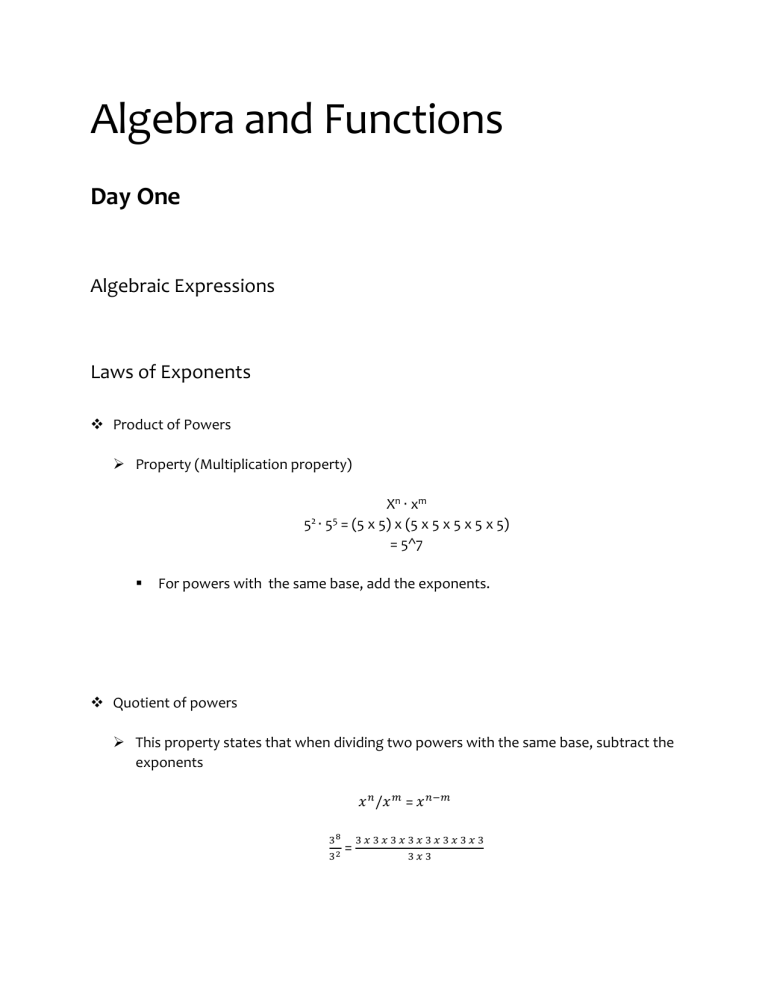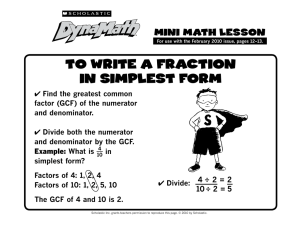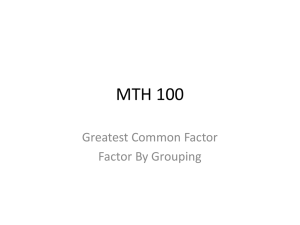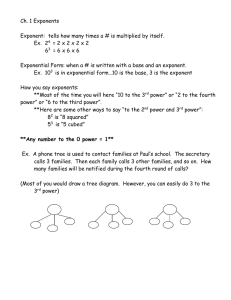
Algebra and Functions Day One Algebraic Expressions Laws of Exponents Product of Powers Property (Multiplication property) Xn ∙ xm 52 ∙ 55 = (5 x 5) x (5 x 5 x 5 x 5 x 5) = 5^7 For powers with the same base, add the exponents. Quotient of powers This property states that when dividing two powers with the same base, subtract the exponents 𝑥 𝑛 /𝑥 𝑚 = 𝑥 𝑛−𝑚 38 32 = 3𝑥3𝑥3𝑥3𝑥3𝑥3𝑥3𝑥3 3𝑥3 Power of a power property This property states that to find a power of a power, multiply the exponents. (82)3 82 𝑥 82 𝑥 82 or (8 x 8) (8 x 8) (8 x 8) Power of a product This property states that when taking the power of a product, multiply the powers of the factors. (3 x 5)6 = 3^6 x 5^6 Factors are the numbers multiplied together to get another number—the multiple. A multiple results from multiplying one number by another. Power of a quotient This property states that when taking the power of a quotient, divide the powers of the numerator and of the denominator. 𝑥 ( ) ^8 = 𝑥 𝑛 /𝑦 𝑛 𝑦 Root as a fractional Exponent and Exponent as a Root Parts of a radical 2 ∛125 In the image above, the index is 3 and the radicand is 125. The index determines the root of the expression. Parts of an exponent 2^7 The exponent is written in a higher position and the number written lower than the exponent is called the base. Writing Root as an Exponent The index of the radical becomes the denominator of the fraction. The radicand becomes the base of the exponential expression. If the radicand of the radical expression has an exponent, the number becomes the numerator of the fraction; otherwise, the number 1 is written as the numerator. am/n = n √a^m 65/3 = ^3 √6^5 Negative exponents A negative power is the multiplicative inverse (reciprocal) of the base raised to the positive opposite of the power. a-3 = 1/a^3 1 / a / a / a = 1/a^3 A negative exponent determines how many times to divide by the number. Start with 1 and then divide as many times as the exponent says. 3 The power of 0 Any number or variable raised to the power 0 is equal to 1. A^0 = an-n Proof By the quotient rule for exponents a^0 = a^n/a^n This becomes a division problem and since the numerator and the denominator are the same, this simplifies to 1. 6^4/6^4 = 1 6^4-4 = 6^0 6/6 = 1 4 Binomial Product Binomial product A binomial is a polynomial with two terms. Special Binomial Products Multiplying a Binomial by itself (Perfect Square Formula) (a + b)^2 = (a + b)(a + b) = a^2 + ab + ab + b^2 = a^2 + 2ab + b^2 Square the first, twice the product, square the last This is a perfect square trinomial. Subtract times subtract. (x-y)(x-y) = x^2 – 2ab + b^2 + y^2 (x-y)^2 = x^2 -2xy + y^2 5 Square the first, twice the product, square the last This is a perfect square trinomial. Difference of two squares (x + y)(x – y) = x^2 – y^2 (x + y)(x-y) = x^2 – xy + xy – y^2 (x-y)(x+y) is the same as the binomial expression in the example. Example: Which binomials multiply to get 4x^2 – 9 This is a difference of two squares because (a+b)(a-b) = a^2 – b^2 4x^2 – 9 = (2x)^2 – (3)^2 (2x + 3)(2x -3) Factoring a Trinomial Important rule a – b = -(b – a) This rule applies both commutative and associative rules. Example: 𝑥 2 − 25 5−𝑥 Apply the difference of two squares formula to simplify x^2 – 25 (x + 5)(x – 5) 6 Apply the a -b = -(b-a) rule to make the denominator the same as (x-5) 5 – x = -(x – 5) Trinomial is an equation with three terms. Always check for the GCF by breaking down every term into prime factors. Rewrite a quadratic expression in standard form by putting the degrees in descending order. How to factor polynomials 6x^4 – 12x^3 + 4x^2 Break down every term into prime factors. Look for factors that appear in every single term to determine the GCF. Factor the GCF out from very time in front of parentheses and leave the remnants inside the parentheses. Multiply out to simplify each term. FOIL method of factoring Check for the GCF first x^2 + 3x – 10 No factors are common to each term, so there is no GCF. Multiply the quadratic and the constant term. 1x^2 -10 = -10x^2 7 Write down all of the factors of the result, in pairs. -1x and 10x 1x and -10x From this list, find the pair that adds to produce the coefficient of the linear term (degree raised to the 1) -2x x 5x = -10x^2 and -2x + 5x = 3x Break up the linear term into two terms using the numbers from the previous step as the cefficients. 3x becomes -2x x 5x X^2 – 2x +5x – 10 Arrange the linear term with the smallest coefficient first. Group the four terms into sets of two. Always put a plus sign between the two sets. Find the GCF for each set and factor it out. Find the GCF for the first two terms, then the GCF for the next two terms. Find the GCF of the two new terms 8 Factor out the GCF from both terms (the expression inside the parentheses to the front) The terms that aren’t in the GCF should be inside the new parentheses. Examples: Factor y^2 + 8y + 16 Rewrite in the form of a^2 + 2ab + b^2 16 = 4^2 8y = 2y x 4 Y^2 + 2y x 4 + 4^2 Apply perfect square formula. 9 Y^2 + 2y x 4 + 4^2 = (y + 4)^2 Factoring the Sum and Difference of Cubes Sum of Cubes X^3 + y^3 = (x + y)(x^2 – xy + y^2) Difference of Cubes X^3 + y^3 = (x - y)(x^2 – xy + y^2) Rationalize denominator -= m ultiply by the conjugate 10 Day Two Functions and Graphs A function takes an input and produces an output. In function notation, f(x), f is the name of the function, x is the input variable, and f(x) is the output. y = f(x) In this formula, y is a function of x, meaning that when the value of x changes, the value of y, the range, changes as well. It is only a function if every x value corresponds to only one y value. A function, f, is a rule that assigns to each element of a set X exactly one element from the set Y. 11 The set X of all possible values of the independent variable is called the Domain of the function. The set Y of all possible values of the dependent variable is called the Range of the function. Variables A variable is something that is measured. An independent variable stands alone and is not changed by other variables being measured. The independent variable belongs on the x-axis of the graph. A dependent variable is something dependent on other factors. The dependent variable belongs on the y-axis. How to distinguish between independent and dependent variables Insert the names of the two variables in this sentence. (Independent variable) causes a change in (Dependent variable) and it is not possible that (Dependent variable) could cause a change in (Independent variable). Domain and Range The domain of a function is the set of values that is plugged into the function. 12 This is the set of all possible x-values which will make the function work and output real y-values. The range of a function is the set of possible numbers that represent every possible value y based on the function. This set is the values the function shoots out after plugging an x value in, which are the y values. How to find the domain of a function Find the x values that the function can accept. It indicates the restrictions on what can be used as an input. Potential causes for a function’s inability to accept an x-value: Dividing by 0 Negative square roots How to find the range of a function To find out some details about the relationship between the two variables, write the formula y = f(x) to obtain the range of a function. Example: If you apply for a $10/day gym membership, the total cost, f(x), is equal to the number of days you sign up for a membership. The formula becomes f(x) = 10(x) The given example shows a positive relationship between x and y when signing up for a gym membership. Knowing that negative days do not exist, the range of the function can never be zero. The range of the function can all be real numbers greater than or equal to 1, x ≥ 1. Make sure to look for the minimum and maximum values of y. 13 14 Interval and set notation Rectangular coordinates System of coordinates is a method of representing points in a space by coordinates. The rectangular coordinate system on a plane is represented by two perpendicular axes x and y which intersect at the point called the origin. The coordinates of the origin are (0,0) The x coordinate (the first number of the pair) is the displacement of the point from the origin along the x-axis. Displacement (Noun) – The straight line distance in a particular direction. The y coordinate (the second number of the pair) is the displacement of the point from the origin along the y-axis. If the displacement is up from the origin, then the y coordinate is positive; if the displacement is down from the origin, it is negative. Coordinate plane 15 Day Three Solving Equations Solve for an equation by finding the values of the variable that make it true. Perform the same operation on both sides of the equation to solve simple equations. Formulas and Literal Equations Apply inverse operation to change the subject of a formula. A formula is a rule that relates two or more quantities using mathematical symbols. Complex equations that require factorisation https://thirdspacelearning.com/gcse-maths/algebra/rearrangingequations/#:~:text=Typically%20we%20rearrange%20equations%20and,side%20of%20th e%20equal%20sign. 16 Linear function A function written in the form Y = mx + b Where m ≠ 0 and b are some fixed numbers. This is known as gradient/y-intercept form. M is a gradient or a slope of the line If (x1,yy1) and (x2,y2) are any two points on the line, then… 𝑦2−𝑦1 M = 𝑦2 − 𝑥2−𝑥1 If m is a gradient of the line and (x1,y1) is a point on the line, then the equation of the line can be derived using gradient/point form. y – y1 = m(x,x1) The distance between any two points (x1,y1) and (x2,y2) 17 B is called y-intercept and b is the value of y when x = 0 √(𝑥2 − 𝑥𝑥1)2 + (𝑦2 − 𝑦1)^2 The midpoint of the interval joining (x1,y1) and (x2,y2) has coordinates. The general form of the linear function is Ax + By + C = 0 18




